Asian Fairy-Bluebird
- December 17, 2023
- 0 comment
The Asian Fairy-Bluebird (Irena puella) is a medium-sized, arboreal passerine bird that is found in forests across tropical southern Asia. It is the sole member of the genus Irena and family Irenidae. The male Asian Fairy-Bluebird is a stunningly beautiful bird, with iridescent blue upperparts and black underparts and flight feathers. The female is a duller blue-green.
Physical Appearance

Fairy-Bluebird
- Lifespan: 10-15 years
- Habitat: Tropical Forests, Plantations, and Secondary Forests.
- Diet: Beetles, Caterpillars, and Flies. They also eat Fruits and Berries.
- Size: 20-25 cm
- Weight: Between 30 and 70 grams
- Wingspan: 30-35 cm
- Conservation Status: Least Concern.
- Population Trend: The population of all three species of fairy-bluebird is stable or increasing.
The Asian Fairy-Bluebird is a shy and elusive bird, and is rarely seen in the open. It is most often seen in the canopy of tall trees, where it feeds on fruits and nectar. It is also known to eat insects. The Asian Fairy-Bluebird is a vocal bird, and its call is a loud, clear whistle. Asian Fairy-Bluebird is a solitary bird, but it is sometimes seen in small groups. It is a territorial bird, and will defend its territory from other birds. The Asian Fairy-Bluebird is a monogamous bird, and pairs will mate for life.
Feather Coloration
The iridescent blue plumage of male fairy-bluebirds is produced by a unique structure of their feathers. The barbs on the tips of their feathers are very thin and transparent, and they have a honeycomb-like structure. This structure allows the feathers to scatter light, producing the iridescent blue color.
Male Fairy-bluebird
- Upperparts: Iridescent blue, with a metallic sheen
- Underparts: Black, with a slight blue tinge
- Flight feathers: Black
- Bill: Black
- Iris: Bright red

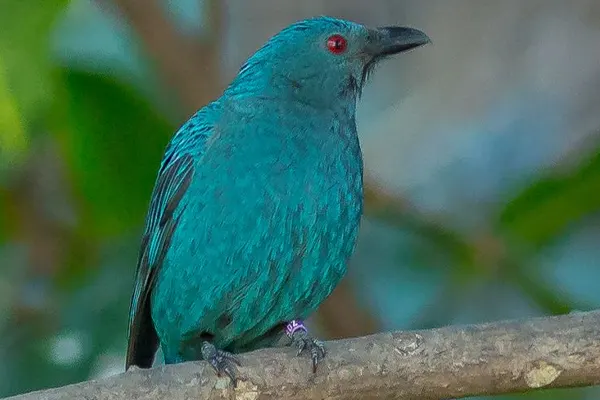
Female Fairy-bluebird
- Upperparts: Dull blue-green
- Underparts: Dull blue-green, with a slightly paler belly
- Flight feathers: Blackish, with blue edges
- Bill: Black
- Iris: Brick red or orange red
The duller plumage of female fairy-bluebirds is thought to be an adaptation that helps them to camouflage themselves in the forest. The blue-green color of their feathers is similar to the color of leaves, and this helps them to blend in with their surroundings.
Flight Characteristics of Asian Fairy-Bluebird
The flight characteristics of the Asian Fairy-bluebird (Irena puella) are well-adapted to its arboreal lifestyle. Its wings are short and rounded, giving it excellent maneuverability in the dense canopy of its forest habitat. Its tail is long and graduated, providing stability and control during quick changes in direction.
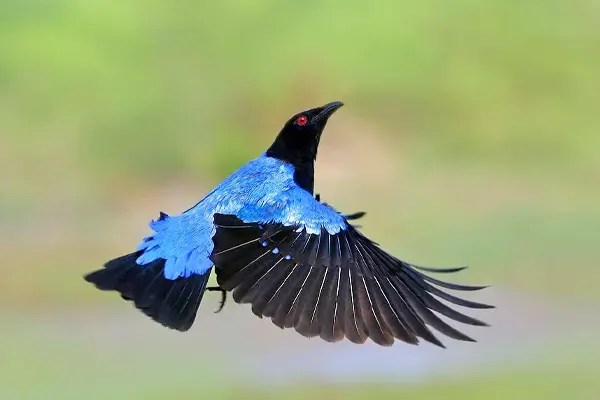
- Wingbeat: The Asian Fairy-bluebird has a rapid wingbeat, which generates the power needed for its maneuverable flight.
- Maneuverability: The short, rounded wings and long, graduated tail give the Asian Fairy-bluebird excellent maneuverability in the dense forest canopy.
- Hovering: The Asian Fairy-bluebird is capable of hovering in mid-air, which allows it to feed on insects or nectar from flowers.
- Acrobatic displays: The Asian Fairy-bluebird is known for its acrobatic aerial displays, which are often performed during courtship.
Migration Patterns of Asian Fairy-Bluebird
The Asian Fairy-bluebird (Irena puella) is a non-migratory bird species, meaning it does not travel long distances between breeding and non-breeding grounds. It remains within its tropical forest habitat throughout the year.

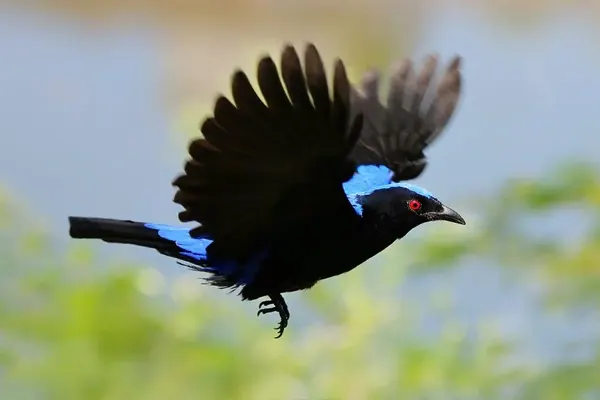
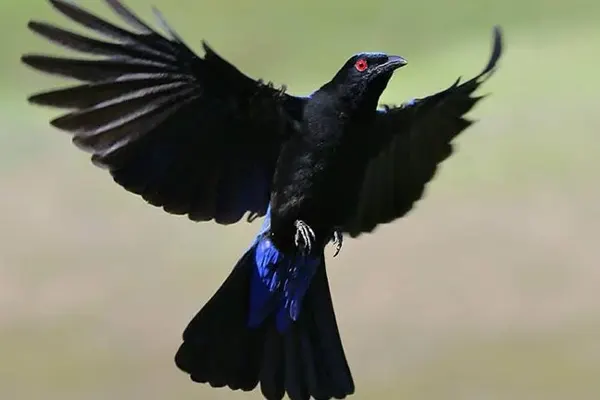
Within its range, the Asian Fairy-bluebird is relatively sedentary, meaning it does not move large distances. However, it may move short distances within its territory to follow food sources or escape predators.
The non-migratory lifestyle of the Asian Fairy-bluebird is likely due to the fact that its tropical forest habitat provides it with a year-round food supply and suitable breeding conditions. There is no need for the species to migrate to a different location in order to survive.
Habitat & Distribution of Asian Fairy-Bluebird
The Asian Fairy-bluebird prefers evergreen forests, but it can also be found in deciduous forests, bamboo forests, and mangrove forests. It is most commonly found in the lowlands, but it can also be found at higher elevations.
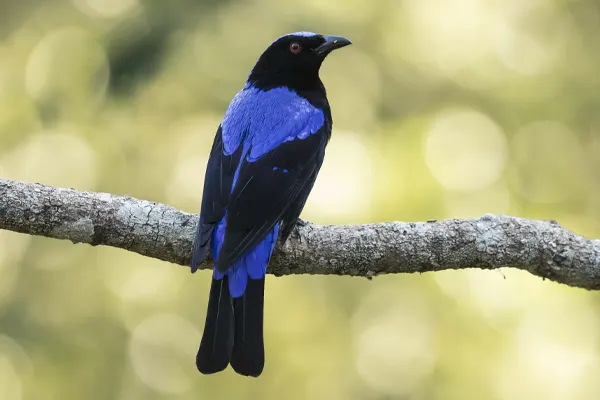
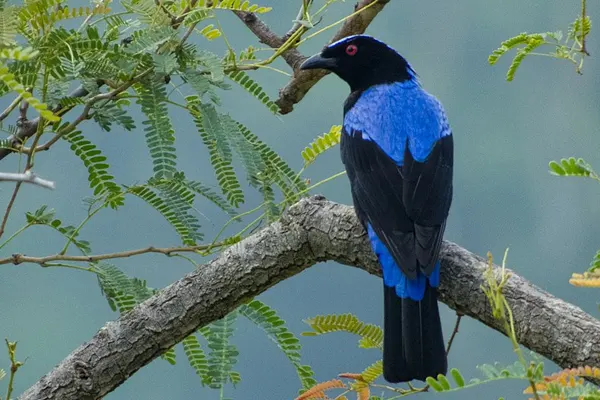
- Evergreen forests
- Deciduous forests
- Bamboo forests
- Mangrove forests
- Cultivated areas
The Asian Fairy-bluebird is the most widespread of the three species, found in tropical forests from India to Vietnam and down into Borneo and Sumatra. It is also found on the Andaman and Nicobar Islands. The species is rare in Sri Lanka.
Behavioral Traits of Asian Fairy-Bluebird
Fairy-bluebirds are generally solitary birds, but they may sometimes be seen in small groups, especially when feeding. They are also territorial, and will defend their territory from other fairy-bluebirds and other bird species.
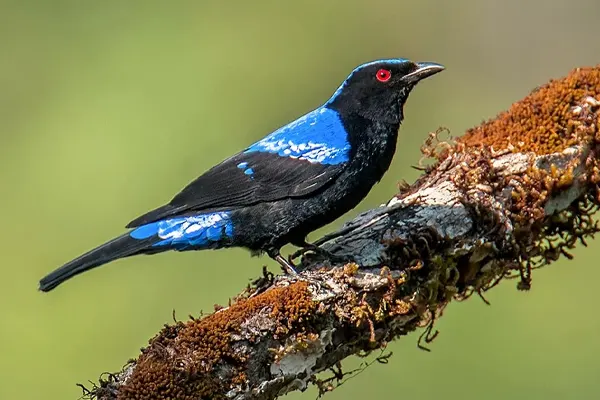

Fairy-bluebirds are active foragers, and they spend much of their day searching for food. They are skilled aerialists, and they are often seen hovering in mid-air to pick insects off of leaves. They also use their long tails to balance themselves as they search for food on tree trunks and branches. Fairy-bluebirds are fascinating birds with a variety of interesting behavioral traits. They are intelligent, social, and beautiful birds that are an important part of the tropical forest ecosystem.
Role in Ecosystem of Asian Fairy-Bluebird
Fairy-bluebirds primarily eat fruits, and play an important role in seed dispersal. As they consume fruits, they swallow the seeds whole. These seeds pass through their digestive system and are then deposited in their droppings. This helps to disperse seeds throughout the forest, which allows new trees to grow.
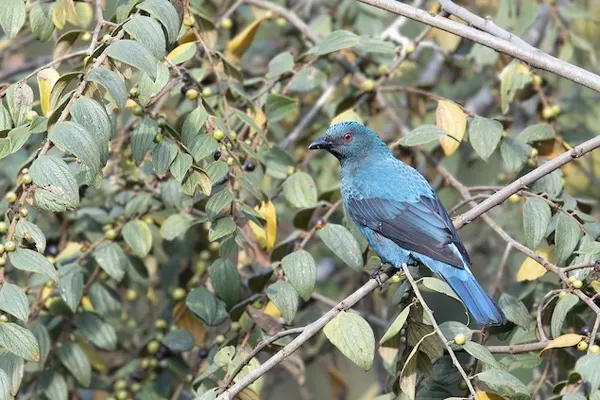
Fairy-bluebirds are important members of the tropical forest ecosystem. They play a vital role in seed dispersal, pollination, and pest control. Their presence helps to maintain the health and diversity of tropical forests.
Dietary Habits of Asian Fairy-Bluebird
The diet of fairy-bluebirds primarily consists of fruits, but they also consume insects, nectar, and pollen. Their specific food preferences vary depending on the species and the availability of food sources in their habitat. Fruits are the most important component of the fairy-bluebird’s diet. They consume a wide variety of fruits, including berries, figs, and drupes. The size of the fruits they eat varies depending on the species. For example, the Asian Fairy-bluebird (Irena puella) prefers larger fruits, while the Philippine Fairy-bluebird (Irena cyanogastra) prefers smaller fruits.
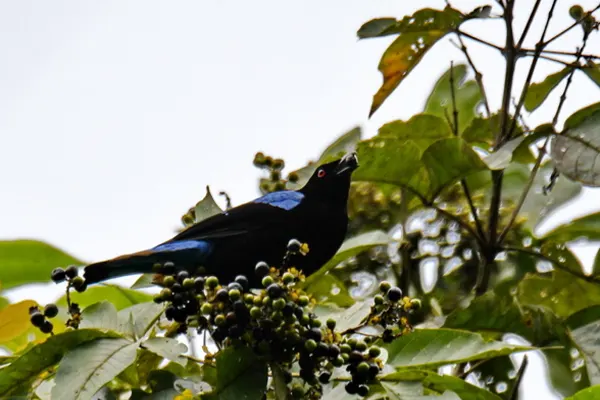

- Insects: Are another important food source for fairy-bluebirds. They consume a variety of insects, including beetles, flies, caterpillars, and ants. They catch insects in mid-air or glean them off of leaves and branches.
- Nectar: Fairy-bluebirds also consume nectar from flowers. They are attracted to flowers with brightly colored petals and sweet-smelling nectar. They use their long, slender bills to reach the nectar deep inside flowers.
- Pollen: Fairy-bluebirds also consume pollen from flowers. They brush against pollen-laden flowers as they feed on nectar, and the pollen sticks to their feathers. The pollen is then transferred to other flowers as they move from flower to flower, which helps to pollinate the plants.
- Seasonal Variations in Diet: The diet of fairy-bluebirds can vary depending on the season. During the breeding season, they may consume more insects to provide protein for their growing chicks. During the non-breeding season, they may consume more fruits, as they are a reliable source of food.
Interesting Facts of Asian Fairy-Bluebird
- Fairy-bluebirds are found in tropical forests across southern Asia. There are three species of fairy-bluebirds: The Asian Fairy-bluebird (Irena puella), the Philippine Fairy-bluebird (Irena cyanogastra), and the Palawan Fairy-bluebird (Irena tweeddalii).
- Fairy-bluebirds are primarily frugivores, but they also eat insects, nectar, and pollen. They play an important role in seed dispersal and pollination in tropical forests.
- Fairy-bluebirds are monogamous and mate for life. They build their nests in trees, and the female lays 2-3 eggs. Both parents incubate the eggs and care for the chicks.
- Fairy-bluebirds are threatened by habitat loss and deforestation. They are also hunted for their plumage in some parts of their range.
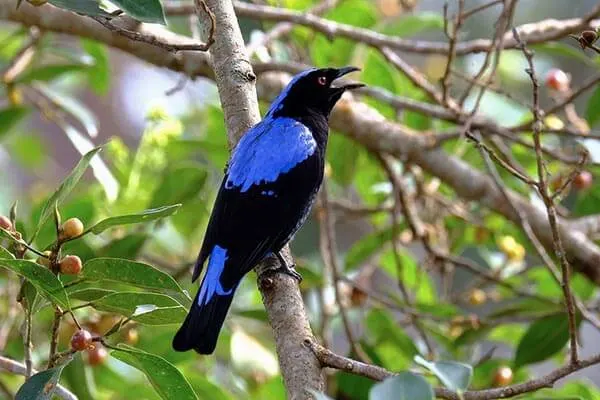
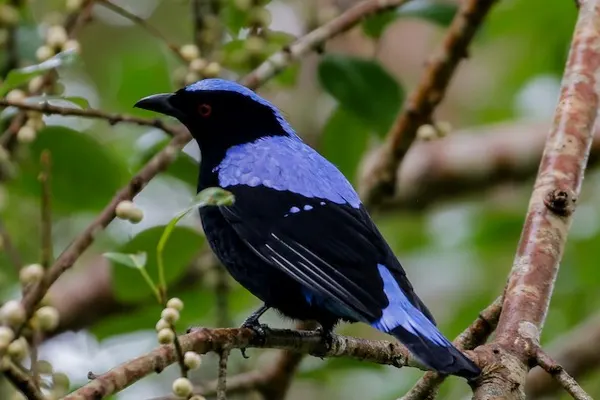
- Fairy-bluebirds are excellent mimics. They can mimic the calls of other birds, as well as the sounds of other animals.
- Fairy-bluebirds are very agile flyers. They are able to hover in mid-air and change direction quickly.
- Fairy-bluebirds are important symbols in some cultures. In the Philippines, the fairy-bluebird is considered to be a sacred bird. In Malaysia, the fairy-bluebird is associated with love and fidelity.
Nesting Habits of Asian Fairy-Bluebird
Fairy-bluebirds are known for their beautiful, cup-shaped nests, which they typically build in the lower to middle canopy of tall trees. These nests are typically constructed by the female, and they are made of a variety of materials, including twigs, leaves, moss, and spider webs.
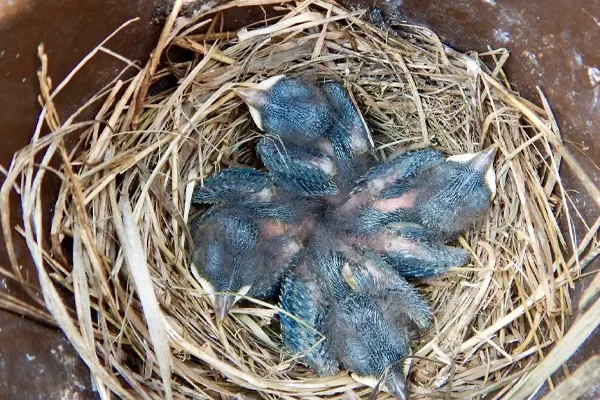
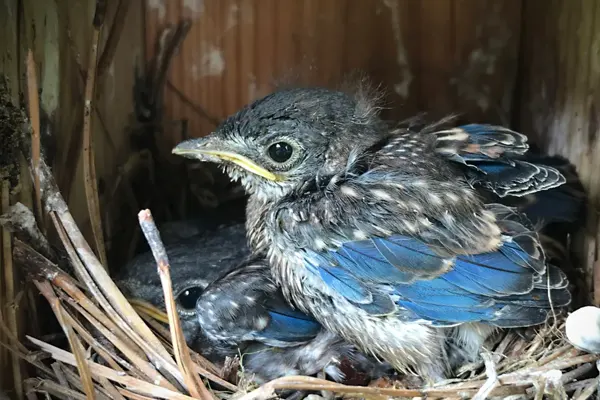
The female fairy-bluebird will lay two to three eggs in her nest, and both parents will take turns incubating the eggs. The incubation period lasts for about 12 days, and after the chicks hatch, both parents will continue to care for them until they are fledged.
- Nest location: Fairy-bluebirds typically build their nests in the lower to middle canopy of tall trees. They prefer evergreen trees, but they will also nest in deciduous trees and bamboo forests.
- Nest construction: The nest is typically made of twigs, leaves, moss, and spider webs. The female fairy-bluebird will build the nest herself, and it will take her several days to complete.
- Egg laying: The female fairy-bluebird will lay two to three eggs in her nest. The eggs are typically blue-green in color, and they are speckled with brown.
- Incubation: Both parents will take turns incubating the eggs. The incubation period lasts for about 12 days.
- Chick care: Both parents will continue to care for the chicks after they hatch. They will feed the chicks insects, fruits, and nectar. The chicks will fledge from the nest after about two weeks.
- Nest reuse: Fairy-bluebirds will sometimes reuse their nests in subsequent years.
Calls & Vocalizations of Asian Fairy-Bluebird
The Asian Fairy-bluebird (Irena puella) has a loud, clear whistle that is often described as a “two-part whistle” or a “double whistle.” The whistle is used by both males and females to communicate with each other, and it is also used to attract mates and defend territory.
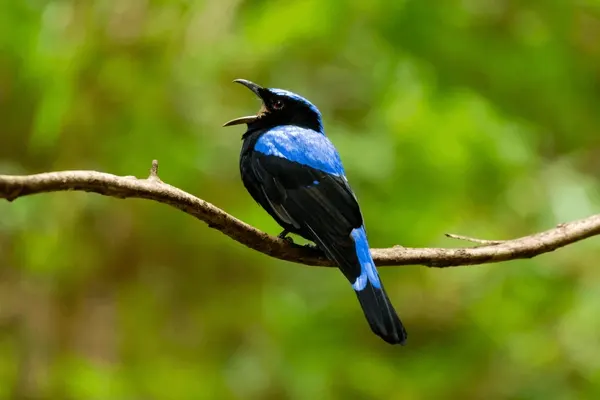
The Philippine Fairy-bluebird (Irena cyanogastra) has a similar whistle to the Asian Fairy-bluebird, but it is slightly higher pitched. The Palawan Fairy-bluebird (Irena tweeddalii) has a more varied vocalization, including whistles, trills, and chatters.
Ecological Significance of Asian Fairy-Bluebird
Fairy-bluebirds play an important ecological role in tropical forests across southern Asia. They are primarily frugivores, but they also eat insects, nectar, and pollen. As a result, they play an important role in seed dispersal and pollination in these ecosystems. Additionally, their consumption of insects helps to control pest populations.

Fairy-bluebirds are important members of the tropical forest ecosystem. They play a vital role in seed dispersal, pollination, and pest control, and their presence helps to maintain the health and diversity of these forests.
Conservation Status of Asian Fairy-Bluebird
The Asian Fairy-bluebird is the most widespread of the three species, and it is not currently considered to be threatened. However, the other two species are threatened by habitat loss and hunting.
The Philippine Fairy-bluebird is endemic to the Philippines, and it is found in a variety of habitats, including lowland forests, montane forests, and secondary forests. However, its habitat is being lost due to deforestation and conversion to agriculture. The species is also hunted for its plumage, which is used in the pet trade.
- Asian Fairy-bluebird (Irena puella): Least Concern
- Philippine Fairy-bluebird (Irena cyanogastra): Near Threatened
- Palawan Fairy-bluebird (Irena tweeddalii): Least Concern
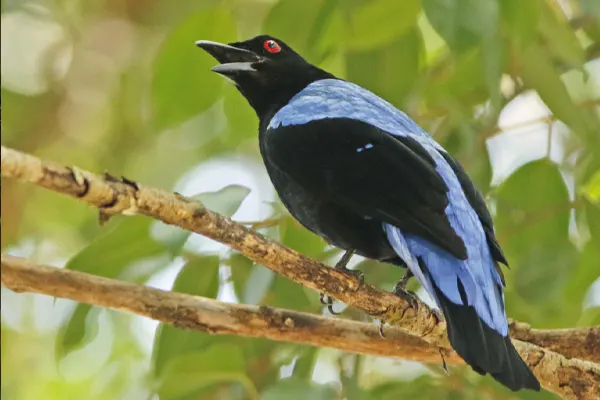

The Palawan Fairy-bluebird is endemic to Palawan and the Calamian Islands in the Philippines. It is found in lowland forests and montane forests. However, its habitat is also being lost due to deforestation and conversion to agriculture.
The conservation status of fairy-bluebirds is a cause for concern. Two of the three species are threatened, and the other species is not currently considered to be threatened, but its population is declining.
Research and Ongoing Studies of Asian Fairy-Bluebird
Researchers are using Geographic Information Systems (GIS) and remote sensing data to identify potential habitat for fairy-bluebirds. This information can be used to guide conservation efforts and inform land-use planning decisions. Conducting regular surveys to monitor the population size and trends of fairy-bluebirds. This information is important for assessing the conservation status of the species and identifying potential threats.
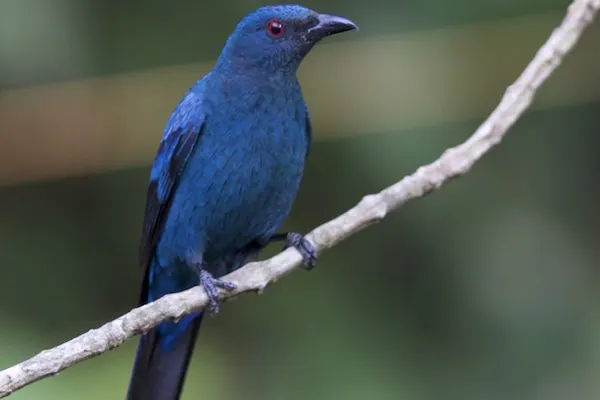
- Breeding Ecology and Reproductive Success of Fairy-bluebirds: Researchers are studying the breeding ecology of fairy-bluebirds, including their nest site selection, clutch size, incubation period, and fledging success. This information is important for understanding the reproductive biology of the species and identifying factors that may affect their reproductive success.
- Diet and Feeding Ecology of Fairy-bluebirds: Researchers are studying the diet of fairy-bluebirds to determine the types of fruits, insects, and nectar they consume. This information is important for understanding the ecological role of the species and identifying potential threats to their food sources.
- Impacts of Habitat Loss and Fragmentation on Fairy-bluebirds: Researchers are studying the impacts of habitat loss and fragmentation on fairy-bluebird populations. This information is important for understanding the threats to the species and developing effective conservation strategies.
- Conservation Genetics of Fairy-bluebirds: Researchers are using genetic techniques to study the genetic diversity and population structure of fairy-bluebirds. This information is important for identifying potential threats to the species and developing conservation strategies that consider genetic factors.
- Community-Based Conservation Efforts for Fairy-bluebirds: Researchers are working with local communities to develop and implement community-based conservation efforts for fairy-bluebirds. This includes raising awareness about the species, promoting sustainable land-use practices, and establishing protected areas.
- Captive Breeding and Reintroduction Programs for Fairy-bluebirds: Researchers are exploring the potential of captive breeding and reintroduction programs to help conserve threatened fairy-bluebird populations. This includes developing captive breeding protocols and identifying suitable reintroduction sites.
- Policy Advocacy for Fairy-bluebird Conservation: Researchers are working with policymakers to advocate for policies that support the conservation of fairy-bluebirds. This includes supporting the development and implementation of laws and regulations that protect the species and its habitat.
Educational and Ecotourism Opportunities of Asian Fairy-Bluebird
Fairy-bluebirds are stunningly beautiful birds with an intriguing natural history, making them excellent subjects for educational and ecotourism initiatives. Their presence in tropical forests across southern Asia provides valuable opportunities for promoting environmental awareness, fostering connections with nature, and supporting local communities.

- Birdwatching Tours: Develop guided birdwatching tours that focus on spotting fairy-bluebirds in their natural habitat. Train local guides to provide expert insights into the birds’ behavior and ecology, while ensuring minimal disturbance to their environment.
- Nature Photography Workshops: Organize photography workshops focused on capturing the beauty of fairy-bluebirds and their habitat. Educate participants on ethical photography practices and encourage them to share their images to promote conservation awareness.
- Ecolodges and Nature Retreats: Establish ecolodges and nature retreats in areas with fairy-bluebird populations, offering visitors immersive experiences in the natural world. Promote sustainable practices and educate guests about the importance of conserving the birds and their habitat.
- Community-Based Ecotourism Initiatives: Collaborate with local communities to develop ecotourism enterprises that focus on fairy-bluebird conservation. Train community members as guides, provide opportunities for local craft sales, and involve them in decision-making processes.
Conclusion
Fairy-bluebirds are fascinating birds with a rich natural history and ecological significance. They are found in tropical forests across southern Asia, playing vital roles in seed dispersal, pollination, and pest control. Their stunning plumage and intriguing behaviors make them excellent subjects for educational and ecotourism initiatives.
Conservation Status and Threats
Despite their importance, fairy-bluebirds face several threats, including habitat loss due to deforestation, hunting for their plumage, and the introduction of invasive species. Two of the three species, the Philippine Fairy-bluebird and the Palawan Fairy-bluebird, are classified as Near Threatened, while the Asian Fairy-bluebird is considered Least Concern but is experiencing population declines.
Conservation Efforts
Conservation efforts are underway to protect fairy-bluebirds and their habitats. These efforts include habitat restoration, community-based conservation programs, captive breeding and reintroduction initiatives, and public education campaigns.
Future of Fairy-bluebirds
The future of fairy-bluebirds depends on our ability to address the threats they face and continue conservation efforts. By protecting their habitats, promoting sustainable land-use practices, and raising awareness about their importance, we can ensure that these beautiful birds continue to grace our planet’s tropical forests.



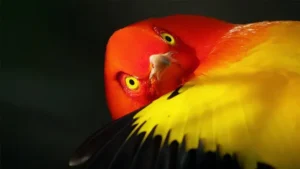



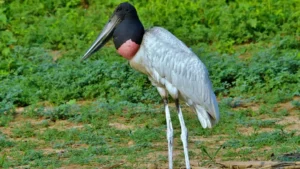



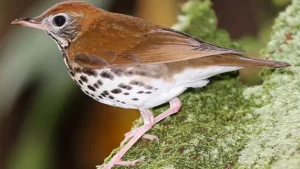
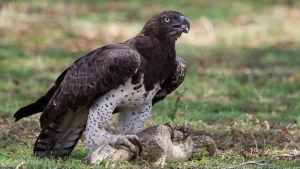
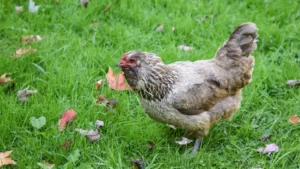
Leave your comment